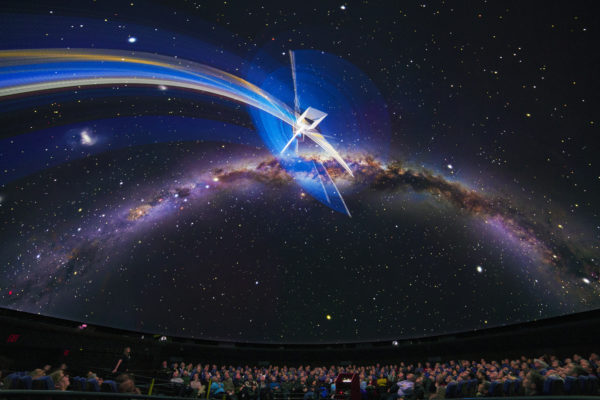New York City’s American Museum of Natural History is celebrating both its 150th anniversary and the 50th anniversary of the Apollo 11 Moon landing this week with the unveiling of its renovated Arthur Ross Hall of Meteorites and a brand-new Christie laser projection system in its famed Hayden Planetarium Dome.
Timed with the July 20 anniversary of the Moon landing, the Museum is also hosting “SpaceFest” this Saturday, a day of family-friendly presentations and performances, including “To the Moon,” a 15-minute virtual reality experience created by Laurie Anderson and Hsin-Chien Huang.
At a press preview yesterday, guests got an advance look at the Hall of Meteorites and its displays, which include three Moon rocks and a newly acquired lunar meteorite sample. Then it was on to the Hayden Planetarium, for a data-driven simulation of the Apollo 11 and Apollo 17 missions, which will be one of the featured events on Saturday.
“We will be recreating the Apollo 11 mission right here, so that visitors will experience the mission as if they were one of the astronauts, seeing exactly what the astronauts saw themselves,” said Ellen Futter, president of the Museum. “That mission recreation will be piloted, if you will, by our director of astrovisualization, Carter Emmart, in collaboration with Open Space, a NASA-funded open-source interactive data visualization software.”
The press preview tracked the journey of the Apollo 11 astronauts, coming closer and closer to the Moon’s surface on the giant Planetarium dome, utlizing actual detailed photographs taken during the mission. Even more detailed were the photographs taken during the Apollo 17 mission, the last manned journey to the Moon in 1972.
Futter noted, “The Hayden Dome recently underwent a major upgrade and is now outfitted with a high dynamic range projector system that is the first of its kind in a planetarium anywhere. The projector’s contrast ratio went from 7,000 to one to greater than one million to one, which means visitors will see both the brightest and darkest images in the universe as never before, making the Hayden not only the most advanced planetarium in the world, but the most advanced planetarium ever attempted.”
The installation uses the first six Christie Eclipse RGB pure laser HDR projectors, which will be commercially launched later this year. Christie states that the Eclipse “reproduces true blacks with bright star points without any unwanted residual light levels, as well as simultaneous deep, rich, highly saturated colors that are unprecedented in a planetarium or display environment.” The installation is the end result of years of close collaboration between Christie and the Hayden Planetarium.
Jackie Faherty, senior scientist at the Museum’s Department of Astrophysics, enthused, “With our projection system in this structure, the presentation I’m about to give you is the closest you’re going to get to traveling in space, at least in today’s technology.”
Futter revealed that in 2020, the Planetarium will unveil “a spectacular new space show on the solar system, curated by Dr. Denton Ebel [curator of the Museum’s Deparmtent of Earth and Planetary Sciences], which will be the first stage show to showcase the Hayden Planetarium’s extraordinary new technology.”
The press preview concluded with a panel discussion moderated by Faherty on the future of space exploration, featuring Dr. Ebel; Michael Shara, curator of the Department of Astrophysics’ Division of Physical Sciences; and Ruth Angus, assistant curator in that department.
Museum president Ellen Futter spoke eloquently on the value of space exploration: “As John Kennedy said in his famous 1961 ‘We choose to go to the Moon’ speech, ‘We set sail on this new sea because there is new knowledge to be gained, new rights to be won, and they must be won and used for the progress of all people.’ As we face new horizons and new science-based issues today, be that climate change, human health, environmental destruction, or extraordinary advances in technology, the times of Apollo 11 hold important lessons for us. They remind us of the power of scientific research to tackle big challenges and to answer big questions for people everywhere. They remind us of the adventure of discovery and exploration that can not only be thrilling but unifying and uplifting. And they remind us that science is central to our everyday lives and to our future wellbeing as a global community, perhaps even more so today than in 1969. Ultimately, the moonwalk reminds us of how powerful and productive hope and ingenuity are, especially when we face seemingly insurmountable challenges.”



Share this post